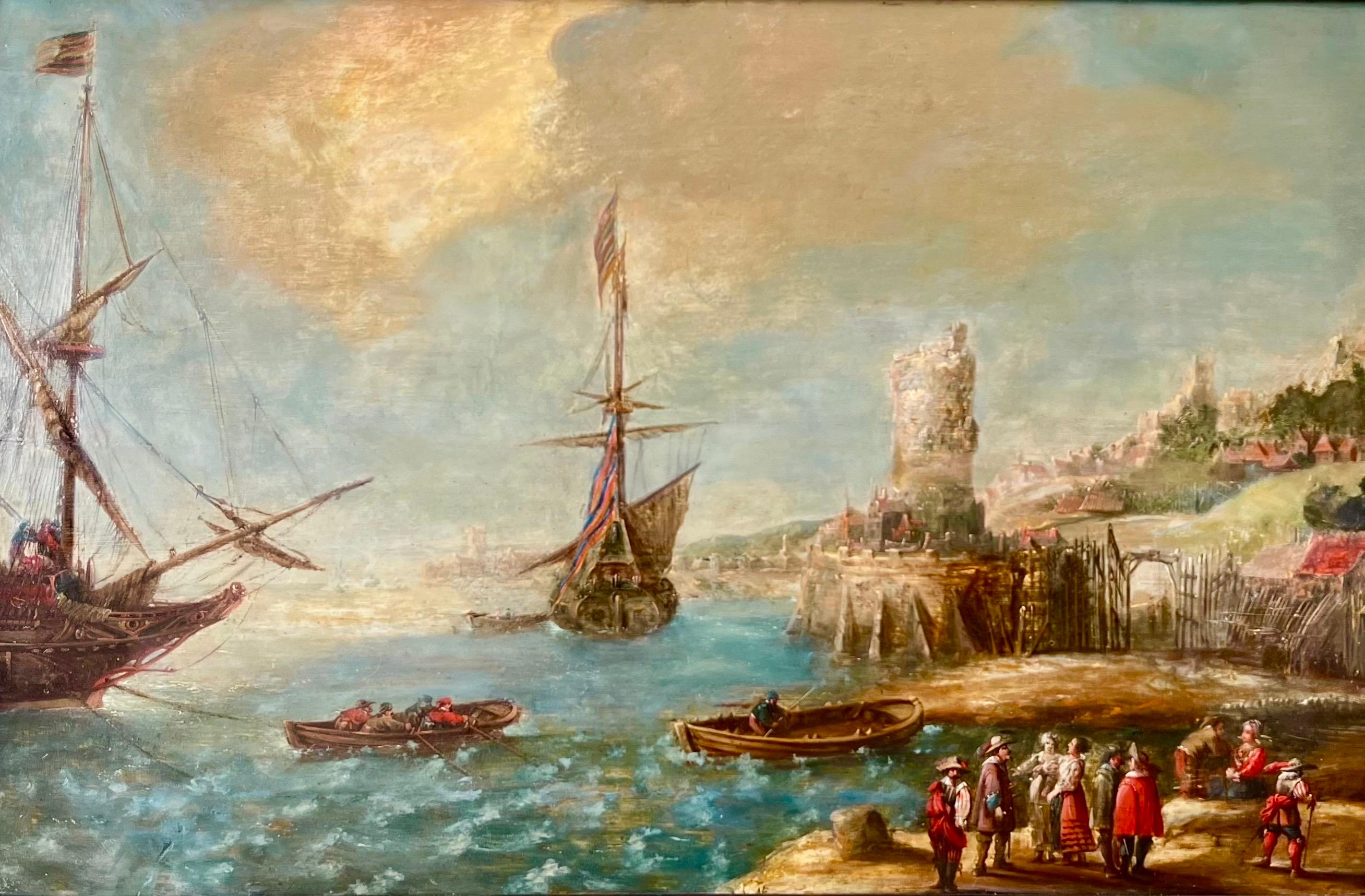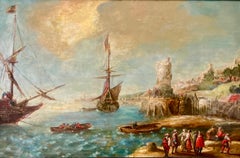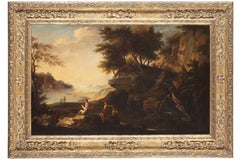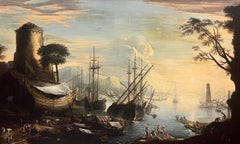Items Similar to Port Moonlight See Landscape Grevenbroeck Paint 17th Century Oil on canvas
Video Loading
Want more images or videos?
Request additional images or videos from the seller
1 of 20
Port Moonlight See Landscape Grevenbroeck Paint 17th Century Oil on canvas1670-1700
1670-1700
$11,145.95
$13,932.4420% Off
£8,246.61
£10,308.2620% Off
€9,256
€11,57020% Off
CA$15,411.26
CA$19,264.0720% Off
A$16,919.64
A$21,149.5520% Off
CHF 8,827.01
CHF 11,033.7620% Off
MX$204,751.19
MX$255,938.9820% Off
NOK 110,632.89
NOK 138,291.1120% Off
SEK 104,245.27
SEK 130,306.5920% Off
DKK 70,475.44
DKK 88,094.3020% Off
About the Item
Giovanni Grevenbroeck, called the Solfarolo (Netherlands, c. 1650 - Milan, post 1699)
Port View in Moonlight
Oil on canvas
70 x 132 cm
Framed 86 x 146 cm
Critical apparatus: Expertise by Emilio Negro.
We are pleased to present this pleasing nocturnal coastal view illuminated by the cold light of the moon, and set in a fantastic harbour with an almost surreal atmosphere, made fascinating by the use of almost monochrome hues with characteristic predominantly brown tones softened by golden reflections.
The marina is organised on the skilful juxtaposition of realistic data with others of pure fantasy, and is therefore characterised by steep heights, imaginary constructions, numerous boats and the presence of many characters engaged in their activities. This compositional choice echoes the works of the many northern European artists active in Italy during the 17th century - from Pieter Mulier (the Cavalier Tempesta) to Adriaen van der Cabel to name but a couple - who spread an alternative to classicist Vedutism, juxtaposing the realist vision with details from their imagination.
All of these elements - together with the unmistakable clouds with their typical atmospheric, chromatic and luministic values - allow us to link our painting to the pictorial corpus of Giovanni Grevenbroeck (Netherlands, c. 1650 - Milan, post 1699), the progenitor of the family of painters from the Netherlands.
The painting expresses all the stylistic and pictorial characteristics of his works, in one of the favourite subjects of his famous workshop: the scene set in a fantasy harbour is the most typical of his repertoire, always somewhere between figurative description and caprice.
After his apprenticeship in Flanders, Giovanni Grevenbroeck came to Italy, specifically to Rome, receiving numerous commissions from the great noble families, such as the Colonna. However, his stay in Rome was a brief interlude in his career, which was to take place largely in Milan, from 1672 onwards, where he spent much of his life painting landscapes and seascapes at dawn and dusk to great success, reported in the inventories of the most important local picture galleries of the time.
His numerous compositions evoke, as is also the case in the canvas under examination, the qualities of 17th-century Roman landscape painting, enlivened by both the northern European examples of Claude Lorrain and the central Italian ones in the style of Salvator Rosa, with the particularity of rendering his port views as flamboyant vedute that entrust the luministic component with the task of highlighting naturalistic details with its typical atmospheric intonations.
To convince oneself of the attribution, one only needs to compare the canvas with the majority of his body of paintings, in particular the seascapes at dawn and sunset from Chateauroux (Musée Bertrand) or, even more so, the Seaports of Alençon (Musée des Beaux-arts et de la Dentelle), works sometimes attributed to one or other of his sons, but which can be traced back to Giovanni thanks to more recent studies of the prolific work of this active family of 17th-century vedutists.
ADDITIONAL INFORMATION:
The work is completed by an antique frame and is sold with a certificate of authenticity and guarantee.
We take care of and organise the transport of the purchased works, both for Italy and abroad, through professional and insured carriers.
It is also possible to see the painting in the gallery in Riva del Garda, we will be happy to welcome you to show you our collection of works.
- Attributed to:Giovanni Grevenbroeck (netherlands, C. 1650 - Milan, 1699)
- Creation Year:1670-1700
- Dimensions:Height: 33.86 in (86 cm)Width: 57.49 in (146 cm)
- Medium:
- Movement & Style:
- Period:
- Condition:
- Gallery Location:Riva del Garda, IT
- Reference Number:1stDibs: LU988115239802
About the Seller
4.9
Platinum Seller
Premium sellers with a 4.7+ rating and 24-hour response times
Established in 2017
1stDibs seller since 2018
260 sales on 1stDibs
Typical response time: <1 hour
- ShippingRetrieving quote...Shipping from: Riva del Garda, Italy
- Return Policy
Authenticity Guarantee
In the unlikely event there’s an issue with an item’s authenticity, contact us within 1 year for a full refund. DetailsMoney-Back Guarantee
If your item is not as described, is damaged in transit, or does not arrive, contact us within 7 days for a full refund. Details24-Hour Cancellation
You have a 24-hour grace period in which to reconsider your purchase, with no questions asked.Vetted Professional Sellers
Our world-class sellers must adhere to strict standards for service and quality, maintaining the integrity of our listings.Price-Match Guarantee
If you find that a seller listed the same item for a lower price elsewhere, we’ll match it.Trusted Global Delivery
Our best-in-class carrier network provides specialized shipping options worldwide, including custom delivery.More From This Seller
View AllLandscape Marina Van Der Velde Old master 17th Century Signed Flemish Paint
Located in Riva del Garda, IT
Quality work attributed to the painter Peter Van Der Velde (Antwerp 1634 - c.1714) - Monogrammed
Coastal view with vessels and perched castle
Oil painti...
Category
17th Century Old Masters Paintings
Materials
Oil
$14,662 Sale Price
35% Off
Landscape Marina See Van Der Velde Paint Oil on canvas Old master 17th Century
Located in Riva del Garda, IT
Quality work attributed to the painter Peter Van Der Velde (Antwerp 1634 - c.1714)
Coastal view with fortified city and boats (city of Antwerp?)
Oil pa...
Category
17th Century Old Masters Paintings
Materials
Oil
$12,210 Sale Price
35% Off
Landscape Mediterranean Coastal View Wyck signed Paint 17th Century Oil canvas
Located in Riva del Garda, IT
Thomas Wyck or Wijck (Bewerwyck 1616- Haarlem 1677) Signed lower left: TWyck (under the floating barrel)
Mediterranean coastal view ca. 1660
Oil on canvas, 43 x 52 cm in frame ...
Category
17th Century Old Masters Paintings
Materials
Oil
Landscape See Paint Oil on canvas Flemish Old master 18th Century Italian Art
Located in Riva del Garda, IT
Flemish painter active in Italy in the eighteenth century
Coastal landscape of the Mediterranean with architectures and figures
Oil painting on canvas (69 x 88 cm., in frame 80 x 100 cm.)
The suggestive view proposed depicts a coastal view with a bay and the ruins of an ancient building, probably a monastery or a church, and in the background another building with a garden surrounded by high walls close to the shore.
The type of landscape, typical of the southern Italian environment, and the intimate atmosphere that welcomes the scene, attributes the authorship of the work to a landscape painter active in the eighteenth century, presumably in Italy in this period, with immediate references to the Dutch school , and in particular to the production of Jacob de Heusch and above all of Gaspar van Wittel, considered the progenitor of Italian landscape painting.
In fact, in the rendering of the architectural details, in the purity with which the buildings have been reconstructed, as well as in the atmosphere that encompasses the entire landscape, a marked correspondence to the so-called "Vanvitellian realism" can be seen: in fact, a comparison with a certain series of views which the Dutchman...
Category
18th Century Old Masters Paintings
Materials
Oil
$7,094 Sale Price
20% Off
See Landscape Night Naval Battle Mercanti 17/18th Century Paint Oil on copper
Located in Riva del Garda, IT
Ilario Mercanti, known as ‘lo Spolverini’ (Parma, 1657 - 1734)
Scene of a night-time naval battle
oil on copper (oval) 59 x 74 cm - with frame 83...
Category
17th Century Old Masters Paintings
Materials
Oil
$7,388 Sale Price
20% Off
De Jode Winter Landscape Paint Oil on canvas Old master 17th Century Flemish Art
Located in Riva del Garda, IT
Hans de Jode (The Hague, 1630 - Vienna, 1663)
Fantasy winter landscape with lake and city on the banks
About 1650
Oils on canvas (62 x 93, in frames 82 x 112)
The work is accompanied by an expertise of Dr. Fred G...
Category
17th Century Old Masters Paintings
Materials
Oil
$9,392 Sale Price
20% Off
You May Also Like
Attributed to John Paul (1804-1887) British Moonlit Coastal Scene Fishing Boats
Located in Cirencester, Gloucestershire
Artist/ School: Attributed to John Paul (1804-1887, British)
Title: Moonlit Coastal Scene
Medium: oil painting on board, framed
Painting: 8 x 10 inches plus its frame
Provenance:...
Category
19th Century Victorian Landscape Paintings
Materials
Oil
17th century Flemish seascape - Ships in a mediterranean harbour - seascape
Located in Aartselaar, BE
Where the Sea Meets Home, A 17th-Century Port Seascape attributed to Andries van Eertvelt
Bathed in the warm and vibrant light of a beautiful day, this remarkable 17th-century seasc...
Category
17th Century Old Masters Landscape Paintings
Materials
Oil, Panel
17th Century by Jacob de Heusch Pair of Landscapes Oil on Canvas
Located in Milano, Lombardia
Jacob De Heusch (Utrecht, Netherlands, 1657 – Amsterdam, Netherlands, 1701)
Title: Pair of Landscapes
Medium: Oil on canvas
Dimensions: without frame 50 x 8...
Category
17th Century Old Masters Landscape Paintings
Materials
Oil, Canvas
Huge 18th Century Italian Oil Painting Shipping in Merchant Port Many Figures
Located in Cirencester, Gloucestershire
The Merchants Port
Italian School, 18th century
oil painting on canvas, framed
framed: 37 x 58 inches
canvas: 32 x 52 inches
provenance: private collection, UK
condition: very good a...
Category
18th Century Old Masters Landscape Paintings
Materials
Oil, Canvas
Dutch Marine Shipping Seascape - Golden Age art Old Master oil painting boats
Located in Hagley, England
This superb Dutch Old Master marine oil painting is attributed to the circle of Jacob de Heusch. Painted circa 1690 the setting is an Italian coast with fish...
Category
17th Century Old Masters Landscape Paintings
Materials
Oil
17th Century by Pieter Mulier Landscape Oil on Canvas
By Pieter Mulier known as the Cavalier Tempesta (Haarlem 1637 - Milan 1701)
Located in Milano, Lombardia
Pieter Mulier known as Tempesta (Haarlem, Netherland, 1637 - Milan, Italy, 1701)
Title: Landscape
Medium: Oil on canvas
Dimensions: without frame 49 x 65...
Category
17th Century Old Masters Landscape Paintings
Materials
Canvas, Oil, Cotton Canvas
More Ways To Browse
17th Century Oil Landscapes
Landscape Netherlands
Antique Apparatus
Pieter Mulier
Street Scene Painting
Mid Century Street Scene Painting
Set Of 3 Oil Paintings
Vintage Coastal Paintings
English Landscape Oil Paintings
Indistinctly Signed
Sacred Art
Trees Oil Paintings 19th Century
Black Flower Painting
Butterfly Painting
Ukraine Paintings
Impressionist Paris
Natural History Museum
Art With Animals







